Sony PCG-FX220, PCG-FX220K, PCG-FX240, PCG-FX240K, PCG-FX250 User Guide
...
Contents |
|
Using Your VAIO® Notebook...................... |
7 |
Using the Keyboard..................................................... |
8 |
Combinations and Functions with the Windows Key ......... |
9 |
Indicators ........................................................................... |
10 |
Indicator Lights.................................................................. |
10 |
Combinations and Functions with the Fn Key................... |
11 |
Using the Touchpad .................................................. |
12 |
Using the Floppy Disk Drive .................................... |
13 |
Using the Optical Drive............................................. |
15 |
Playing a DVD................................................................... |
17 |
Notes on CD and DVD media ........................................... |
18 |
Writing data to CD-RW/CD-R media (For models with a |
|
CD-RW/DVD Combo Drive) ............................................ |
19 |
Using PC Cards ......................................................... |
19 |
To insert a PC Card............................................................ |
19 |
To remove a PC Card......................................................... |
21 |
Using a Second Battery Pack .................................... |
22 |
To insert a second battery pack.......................................... |
23 |
To charge the second battery pack..................................... |
23 |
To remove the second battery pack ................................... |
24 |
Using the Weight Saver............................................. |
25 |
To attach the weight saver ................................................. |
26 |
To remove the weight saver............................................... |
27 |
Using Smart Connect ................................................ |
27 |
Windows Me™.................................................................. |
27 |
Windows 2000 ................................................................... |
28 |
1

Change text in this variable to document title as each document is created. |
|
Power Saving Modes ................................................ |
28 |
Normal Mode .................................................................... |
29 |
Standby Mode ................................................................... |
29 |
To activate Standby mode................................................. |
29 |
To return to normal mode ................................................. |
29 |
Hibernate Mode................................................................. |
29 |
To activate Hibernate mode .............................................. |
29 |
To return to normal mode ................................................. |
30 |
Connecting a Phone Line .......................................... |
30 |
Connecting to a Local Area Network (LAN) ........... |
31 |
Setting Up Your Ethernet Connection .............................. |
32 |
Connecting Peripheral Devices ............... |
33 |
Connecting the Port Replicator................................. |
34 |
Connecting an External Mouse or Keyboard............ |
37 |
Connecting a Parallel Port Printer ............................ |
38 |
Connecting a USB Printer......................................... |
39 |
Connecting an External Display ............................... |
39 |
Connecting a TV Display ......................................... |
42 |
Connecting a Universal Serial Bus (USB) Device ... |
43 |
Connecting an i.LINK® Device................................ |
44 |
Connecting External Speakers .................................. |
46 |
Connecting an External Microphone ........................ |
46 |
Expanding Your Notebook Capabilities ................... |
47 |
Personal Digital Assistant ................................................. |
47 |
Wireless LAN Access Point.............................................. |
48 |
Wireless LAN PC Card..................................................... |
48 |
2

Customizing Your VAIO® Notebook ........ |
49 |
Displaying the Sony Notebook Setup Screen ........... |
50 |
Sony Notebook Setup Tabs................................................ |
51 |
Controlling Power Management ............................... |
51 |
Viewing the Power Management status icons ................... |
52 |
Power Management Profiles.............................................. |
53 |
Power Management Commands ........................................ |
54 |
Conserving Battery Power ................................................. |
55 |
Displaying Battery Information ................................ |
55 |
Battery Icon Descriptions .................................................. |
56 |
Displaying Detailed Battery Information .......................... |
57 |
Selecting the Display Mode ...................................... |
57 |
Changing the Window Design of Sony Software .............. |
59 |
Adding Memory ......................................... |
61 |
Before you start ......................................................... |
61 |
128 MB Memory Models .................................................. |
62 |
192 MB Memory Models .................................................. |
62 |
About the Software on Your Notebook ... |
65 |
Overview ................................................................... |
65 |
MovieShaker™ ......................................................... |
70 |
Importing Images and Sound Clips ................................... |
71 |
Create a Movie using Shaker ............................................. |
71 |
Editing Clips and Scenes ................................................... |
72 |
Adding effects to a scene or a clip..................................... |
72 |
Saving a Movie .................................................................. |
72 |
3

Change text in this variable to document title as each document is created.
PictureGear™ ........................................................... |
73 |
Managing Your Pictures ................................................... |
73 |
Creating a Photo Album.................................................... |
74 |
Using Panorama Maker..................................................... |
74 |
Making Still Images and Panoramic from MPEG ............ |
74 |
OpenMG™ Jukebox ................................................. |
75 |
Electronic Music Distribution (EMD) Services................ |
75 |
Starting OpenMG Jukebox 2.0.......................................... |
76 |
Recording a CD................................................................. |
77 |
Transferring Songs (Check-in/Check-out)........................ |
78 |
Check-out.......................................................................... |
79 |
Check-in............................................................................ |
80 |
Additional OpenMG Jukebox Features............................. |
80 |
Notes on performing the System Restore function of System |
|
Tools on Windows® Millennium Edition ......................... |
81 |
Notes on using Portable Players........................................ |
82 |
Smart Capture ........................................................... |
83 |
Using Still mode................................................................ |
84 |
Using Net Movie mode ..................................................... |
88 |
Using ImageStationSM...................................................................... |
91 |
VisualFlow™............................................................ |
93 |
Using DVgate Software ............................................ |
94 |
DVgate plug-in for Adobe Premiere®........................................ |
94 |
Application, Driver, and System Recovery CDs ...... |
95 |
Using Your Recovery CDs ....................................... |
96 |
Using the Application Recovery CD(s) ............................ |
96 |
Using the Driver Recovery CD(s)..................................... |
97 |
Using the System Recovery CD(s) ................................... |
97 |
Getting Help............................................. |
101 |
Support Options ...................................................... |
101 |
4

VAIO Support Agent .............................................. |
102 |
Using the Quick Fix Wizard ............................................ |
103 |
Using Common Solutions................................................ |
104 |
Automatic Updates .......................................................... |
106 |
Update Notification.......................................................... |
107 |
VAIO Support Agent Properties...................................... |
108 |
Using Support Central ..................................................... |
109 |
Software Support Information................................. |
112 |
Sony Service Center......................................................... |
115 |
Troubleshooting ...................................... |
117 |
Troubleshooting your notebook....................................... |
117 |
Troubleshooting the LCD screen..................................... |
121 |
Troubleshooting the mouse and touchpad ....................... |
122 |
Troubleshooting drives, PC Cards and peripheral devices .... |
|
123 |
|
Troubleshooting software ................................................ |
125 |
Troubleshooting the modem ............................................ |
126 |
Troubleshooting audio ..................................................... |
126 |
Troubleshooting the printer ............................................. |
127 |
5

Change text in this variable to document title as each document is created.
6

Using Your VAIO® Notebook
This section describes how to use your keyboard, touchpad, floppy disk drive, and optical drive. You will also find information on how to connect your notebook to another computer or network.
7

Change text in this variable to document title as each document is created.
Using the Keyboard
Your keyboard is very similar to a typewriter’s, but the keyboard has additional keys that perform specific computer-related tasks.
Keyboard
|
|
|
Correction |
Escape key |
Function keys |
Print Screen key |
keys |
|
|
Shift key |
|
|
|
|
|
|
|
|
|
|
|
|
|
|
|
|
|
|
|
|
|
|
|
|
|
|
|
|
|
|
|
|
|
|
|
|
|
|
|
|
|
|
|
|
|
|
|
|
|
|
|
|
|
|
|
|
|
|
|
|
|
|
|
|
|
|
|
|
|
|
|
|
|
|
|
|
|
|
|
|
|
|
|
|
|
|
|
|
|
|
|
|
|
|
|
|
|
|
|
|
|
|
|
|
|
|
|
|
|
|
|
|
|
|
|
|
|
|
|
|
|
|
|
|
|
|
|
|
|
|
|
|
|
|
|
|
|
|
|
|
|
|
|
|
|
|
|
|
|
|
|
|
|
|
|
|
|
|
|
|
Ctrl key |
|
|
|
|
|
|
|
|
|
|
|
|
|
|
|
|
|
|
|
||
|
|
|
|
|
|
|
|
|
|
|
|
|
|
|
|
|
|
|
|
|||
|
|
|
|
|
|
|
|
|
|
|
|
|
|
|
|
|
|
|
|
|||
|
|
|
|
|
|
|
|
|
|
|
|
|
|
|
|
|
|
|
|
|||
|
|
|
|
|
|
|
|
|
|
|
|
|
|
|
|
|
|
|
|
|||
|
|
|
|
|
|
|
|
|
|
|
|
|
|
|
|
|
|
|
|
|
|
|
|
|
|
|
|
|
|
|
|
|
|
Applications key |
|
|
|
|
|||||||
|
Fn key |
|
|
|
|
|
|
|
Navigation |
|||||||||||||
|
|
|
|
|
|
|
|
|
|
|
|
|
|
|
|
|||||||
|
|
Alt key |
|
|
|
|
|
|||||||||||||||
|
|
|
|
|
|
|
|
|
|
|
|
|
|
|
|
|
keys |
|||||
|
|
|
|
|
|
|
|
|
|
|
|
|
|
|
|
|
|
|
||||
|
|
|
|
Windows key |
Numeric keypad area |
|||||||||||||||||
|
|
|
|
|
|
|
|
|
|
|
|
|
|
|
|
|
|
|
|
|
|
|
|
Key |
Description |
|
|
|
|
|
|
|
|
|
|
|
|
|
|
|
|
||||
|
|
|
|
|
|
|
|
|
|
|
|
|
|
|
|
|
|
|
|
|
|
|
Numeric keypad |
Contains the keys found on a typical calculator. Use the numeric |
|||||||||||||||||||||
area |
keypad area to type numbers or to perform mathematical |
|||||||||||||||||||||
|
|
|
|
calculations such as addition and subtraction. Note that you must |
||||||||||||||||||
|
|
|
|
press the Num Lock key to activate the numeric keypad. (When |
||||||||||||||||||
|
|
|
|
you do so, the Num Lock light will be on.) |
||||||||||||||||||
|
|
|
|
|
|
|
|
|
|
|
|
|
|
|
|
|
|
|
|
|
|
|
Navigation keys |
Several keys are devoted to moving the cursor on the screen. |
|||||||||||||||||||||
|
|
|
|
|
|
|
|
|
|
|
|
|
|
|
|
|
|
|
|
|
|
|
Correction keys |
The Insert, Back Space, and Delete keys enable you to make |
|||||||||||||||||||||
|
|
|
|
corrections in your documents. |
||||||||||||||||||
|
|
|
|
|
|
|
|
|
|
|
|
|
|
|
|
|
|
|
|
|
|
|
Function keys |
The twelve function keys along the top of the keyboard are used |
|||||||||||||||||||||
|
|
|
|
to perform designated tasks. For example, in many applications, |
||||||||||||||||||
|
|
|
|
F1 is the Help key. The task associated with each function key |
||||||||||||||||||
|
|
|
|
may vary from one application to the next. |
||||||||||||||||||
|
|
|
|
|
|
|
|
|
|
|
|
|
|
|
|
|
|
|
|
|
|
|
Escape key |
The Esc (Escape) key is used to cancel commands. |
|||||||||||||||||||||
|
|
|
|
|
|
|
|
|
|
|
|
|
|
|
|
|
|
|
|
|
|
|
8

|
|
|
|
|
|
|
Using the Keyboard |
|
|
|
|
|
|
|
|
|
Key |
Description |
|||||
|
|
|
|
|
|
|
|
Print Screen key |
The Print Screen key takes an electronic snapshot of the screen |
||||||
|
|
|
|
|
|
|
and places it in the Windows Clipboard. You can then paste the |
|
|
|
|
|
|
|
screen shot into a document and print it. |
|
|
|
|
|
|
|
|
Operator keys |
Several keys are always used with at least one other key: Ctrl, |
||||||
(Shift, Ctrl, |
Alt, and Shift. When held down with another key, the Ctrl |
||||||
Alt keys) |
(Control) and Alt (Alternate) keys offer another way to give |
||||||
|
|
|
|
|
|
|
commands. For example, in many applications, instead of |
|
|
|
|
|
|
|
choosing the Save command from a menu, you can hold down |
|
|
|
|
|
|
|
Ctrl and press S (referred to as Ctrl+S). The Shift key operates |
|
|
|
|
|
|
|
the same way as on a typewriter; it is used to produce capital |
|
|
|
|
|
|
|
letters or special symbols, such as @ and $. |
|
|
|
|
|
|
|
|
Windows key |
The key with the Windows logo displays the Windows Start |
||||||
|
|
|
|
|
|
|
menu; it is the equivalent of clicking the Start button on the |
|
|
|
|
|
|
|
taskbar. See “Combinations and Functions with the Windows |
|
|
|
|
|
|
|
|
|
|
|
|
|
|
|
Key” for more information. |
|
|
|
|
|
|
|
|
Fn key |
The Fn key is used in combination with other keys to issue |
||||||
|
|
|
|
|
|
|
commands. See “Combinations and Functions with the Fn Key” |
|
|
|
|
|
|
|
for more information. |
|
|
|
|
|
|
|
|
Applications key |
The Applications key displays a shortcut menu of context- |
||||||
|
|
|
|
|
|
|
sensitive choices. Pressing this key is the equivalent of clicking |
|
|
|
|
|
|
|
|
|
|
|
|
|
|
|
the right mouse button. |
|
|
|
|
|
|
|
|
Combinations and Functions with the Windows Key |
|||||||
|
|
|
|
|
|
|
|
Combination |
Function |
||||||
|
|
|
|
|
|
|
|
|
|
|
|
|
|
+ F1 |
Displays Windows Help. |
|
|
|
|
|
|
||
|
|
|
|
|
|
|
|
|
|
|
|
|
|
+ Tab |
Switches the selected button on the taskbar. |
|
|
|
|
|
|
||
|
|
|
|
|
|
|
|
|
|
|
|
|
|
+ D |
Displays the Desktop. |
|
|
|
|
|
|
||
|
|
|
|
|
|
|
|
|
|
|
|
|
|
+ E |
Displays Windows Explorer. |
|
|
|
|
|
|
||
|
|
|
|
|
|
|
|
|
|
|
|
|
|
+ F |
Displays the Windows Find: All Files window to find a file or |
|
|
|
|
|
|
||
|
|
|
|
|
|
|
folder. This is the equivalent of selecting Find and then Files or |
|
|
|
|
|
|
|
Folders from the Start menu. |
|
|
|
|
|
|
|
|
|
|
|
|
|
|
+ Ctrl + F |
Displays the Windows Find: Computer window where you can |
|
|
|
|
|
|
||
|
|
|
|
|
|
|
locate other computers. This is the equivalent of selecting Find |
|
|
|
|
|
|
|
and then Computer from the Start menu. |
|
|
|
|
|
|
|
|
|
|
|
|
|
|
+ M |
Minimizes all displayed windows. |
|
|
|
|
|
|
||
|
|
|
|
|
|
|
|
9
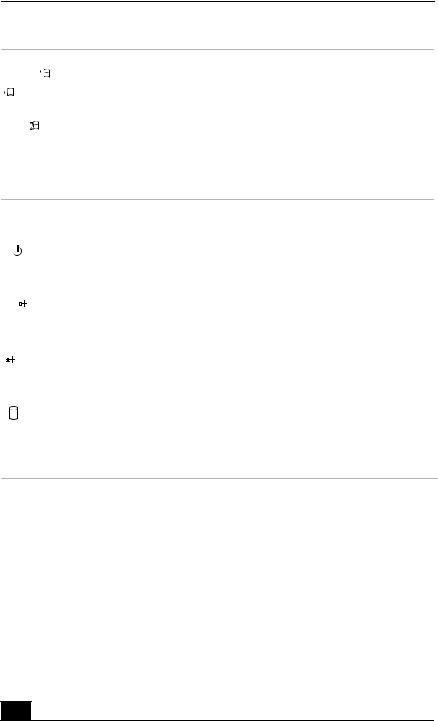
Change text in this variable to document title as each document is created.
Combination |
Function |
|||||
Shift + |
|
+ M |
Returns all minimized windows to their previous size. |
|||
|
||||||
|
|
|
|
|
|
|
|
+ R |
|
|
Displays the Run window. This is the equivalent of selecting Run |
||
|
|
|
||||
|
|
|
|
|
|
from the Start menu. |
|
|
|
|
|
|
|
Fn + |
|
|
+ Insert |
Displays the Properties window. This is the equivalent of double- |
||
|
||||||
|
|
|
|
|
|
clicking the System icon in the Control Panel. |
|
|
|
|
|
|
|
Indicators
Indicator |
Function |
||||
Power |
Light is green when the power to the notebook is turned on, |
||||
|
|
|
|
|
flashes amber in Standby mode, and turns off when the notebook |
|
|
|
|
|
is in Hibernate mode or powered off. |
|
|
|
|
|
|
Battery 1 |
Indicates the status of the battery inserted in the battery bay on |
||||
|
|
|
|
|
the left side of the notebook. |
1 |
|
|
|
|
|
|
|
|
|
||
|
|
|
|
|
|
Battery 2 |
Indicates the status of the battery inserted in the multipurpose |
||||
|
|
|
|
|
drive bay on the right side of the notebook. |
|
|
2 |
|
|
|
|
|
|
|
|
|
|
|
|
|
|
|
Hard disk |
Lights when data is being read from or written to the hard drive. |
||||
|
|
|
|
|
Do not enter Standby mode or turn off the notebook when this |
|
|
|
|
|
indicator light is on. |
|
|
|
|
|
|
Indicator Lights
Light |
On |
Off |
Num |
The number keys in the numeric |
The alphanumeric character keys |
Lock |
keypad are active. |
in the keypad area are active. |
|
|
|
Caps |
The letters appear in uppercase as you |
Letters appear in lower case as |
Lock |
type. The Shift key lowers the case of |
you type (unless you hold down |
|
typed letters when Caps Lock is on. |
the Shift key). |
|
|
|
Scroll |
The screen scrolls differently. (Exactly |
Information moves across the |
Lock |
how it scrolls depends on the specific |
display normally. |
|
application. It has no effect in many |
|
|
applications.) |
|
|
|
|
10

Using the Keyboard
Combinations and Functions with the Fn Key
Combinations/
Feature
Fn+  (ESC)
(ESC)
Standby
Fn+  (F3)
(F3)
Mute On/Off
Fn+  (F4) Speaker volume
(F4) Speaker volume
Fn+  (F5) Brightness control
(F5) Brightness control
Fn+ LCD /  (F7)
(F7)
Switch to the external monitor/ LCD
Fn+ LCD only/
 (F8) Control TV out
(F8) Control TV out
Function
Puts the system into Standby mode, a power management state. To return the system to the active state, press any key or press the power button on your notebook.
Toggles the built-in speaker off and on.
Adjusts the built-in speaker volume. |
or . |
|
To increase volume, press Fn+F4, then |
|
|
To decrease volume, press Fn+F4, then |
or . |
|
Adjusts the brightness of the LCD. |
|
or . |
To increase light intensity, press Fn+F5 and then |
||
To decrease light intensity, press Fn+F5 and then |
or . |
|
Toggles through the LCD, external display (connected to the  Monitor jack) and both LCD and external display.
Monitor jack) and both LCD and external display.
Only LCD |
|
|
LCD and external display |
|
||
|
|
|
||||
|
|
|
Only external display |
|
|
|
|
|
|
|
|
||
Toggles between LCD-only and dual LCD/TV display modes.
Only LCD |
|
|
LCD and external display |
|
||
|
|
|
||||
|
|
|
Only external display |
|
|
|
|
|
|
|
|
||
|
|
Connect the cable before you turn on the notebook, otherwise |
|
|
Fn + F8 will not work. |
|
|
|
Fn+ |
(F12) |
Provides for the lowest level of power consumption. When you |
Hibernate |
execute this command, the state of the system and state of the |
|
|
|
peripheral devices are written to the hard disk and the system |
|
|
power is turned off. To return the system to its original state, use |
|
|
the power button to turn on power. |
|
|
|
Fn+D |
|
Turns off the LCD to save power. To turn the LCD back on, press |
Video standby |
any key (Windows Me™ only). |
|
|
|
|
Fn+ F |
|
Display control. Minimizes and maximizes the LCD screen. If |
|
|
the default display resolution is reduced, this function maximizes |
|
|
the display resolution to fit the screen size. Maximizing the |
|
|
display screen enables you to view the display at a greater |
|
|
resolution. |
|
|
|
11
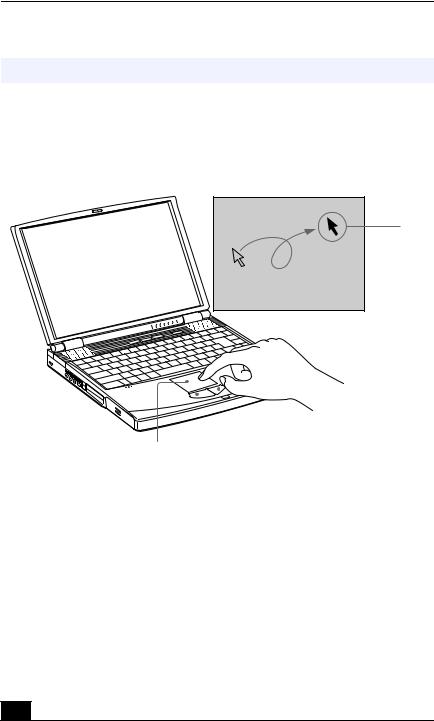
Change text in this variable to document title as each document is created.
Some functions are not available until Windows launches.
Using the Touchpad
The keyboard contains a cursor-pointing device called a touchpad. You can point to, select, drag, and scroll objects on the screen using the built-in touchpad.
Touchpad
Pointer
|
|
Touchpad |
|
|
|
|
|
|
|
|
|
|
|
|
Right button |
||
|
|
|
|
|
|
|
|
|
Left button |
||
|
|
|
|
|
|
|
Action |
Description |
|
|
|
|
|
|
|
||
Point |
Slide one finger on the touchpad to place the pointer on an item |
||||
|
|
or object. |
|
|
|
|
|
|
|
|
|
Click |
Press the left button once. |
||||
|
|
|
|
||
Double-click |
Press the left button twice. |
||||
|
|
|
|
|
|
12

|
|
Using the Floppy Disk Drive |
|
|
|
|
Action |
Description |
|
|
|
Right-click |
Press the right button once. In many applications, this action |
|
|
|
displays a shortcut menu of context-sensitive choices. |
|
|
|
Drag |
Slide one finger while pressing the left button. |
|
|
|
|
Scroll |
Move your finger along the right edge of the touchpad to scroll |
|
|
|
vertically. Move your finger along the bottom to scroll |
|
|
horizontally. (The scroll function is available only with |
|
|
applications that support a touchpad scroll feature.) |
|
|
|
See Mouse Properties for information on touchpad features, such as clicking both buttons simultaneously, adjusting touchpad speed, and Easy Launcher functions. To access Mouse Properties, click the Start button, point to Settings, point to Control Panel, and then click the Mouse icon in the Control Panel.
Using the Floppy Disk Drive
Your notebook comes with the floppy disk drive in the multipurpose bay.
To insert a floppy disk
1Hold the floppy disk with the label side facing up.
2Gently push the floppy disk into the drive until it clicks into place.
Floppy disk
Floppy disk drive 
13

Change text in this variable to document title as each document is created.
To remove a floppy disk
When you finish using the floppy disk, wait until the LED indicator turns off, then press the Eject button to remove the floppy disk.
Eject button
 LED indicator
LED indicator
Do not push the eject button when the LED indicator is turned on. Otherwise, data may be lost.
To remove the floppy disk drive
1Turn off the notebook.
2There is a RELEASE lever on the bottom of the notebook. Slide this lever in the direction of the arrow.
Multipurpose bay release lever
Multipurpose bay RELEASE lever
3Slide the floppy disk drive out of the multipurpose bay.
4Insert the weight saver. See “Using the Weight Saver” for more information.
14
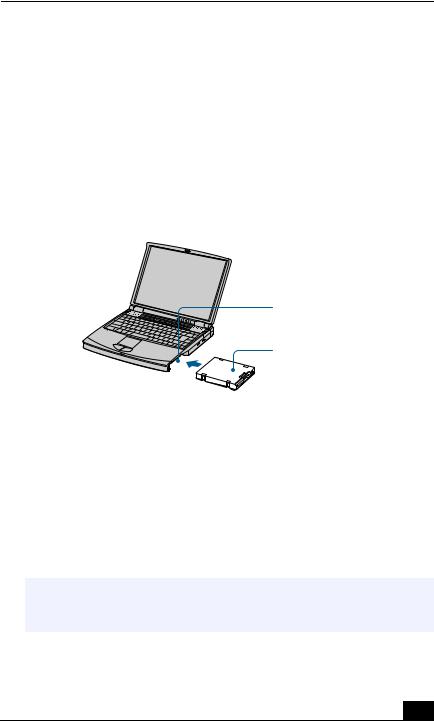
Using the Optical Drive
To reinsert the floppy disk drive
1Turn off the notebook.
2If another device is in the multipurpose bay, remove the device. See “To remove the second battery pack” for more information.
3Insert the floppy disk drive into the multipurpose bay with the VAIO label facing up. Continue pushing the drive into the bay until the RELEASE lever locks into place.
Inserting the floppy disk drive
Multipurpose bay
Floppy disk drive
Using the Optical Drive
Your notebook comes with an optical drive, either a CD-RW/DVD Combo Drive or DVD-ROM drive, depending on the model you purchased.
To insert a disc
1Turn on the notebook.
When the notebook is in Standby or Hibernate mode, you cannot insert a disc. See “Controlling Power Management” for more information on Standby and Hibernate modes.
15

Change text in this variable to document title as each document is created.
2Press the Eject button to open the optical drive. The tray slides out.
Ejecting the tray
Eject button
3Place an optical disc on the tray with the label side facing up. For DVDs that can be played on both sides, the side of the disc facing up is the side that plays.
Do not use adhesive labels to identify your discs. Adhesive labels may come off while the disc is in use in the optical drive(s), and may cause damage to the drive.
4 Push the disc onto the hub until the disc clicks securely into place.
Inserting an optical disc
Label side facing up
16

Using the Optical Drive
5Close the tray by pushing it gently.
Be sure to seat the disc firmly over the hub fingers. If you do not seat the disc firmly, you could damage your optical drive and you may not be able to open the tray.
When you finish using a disc, wait until the LED indicator turns off, then press the Eject button to remove the disc.
When the notebook is in power saving modes, you cannot remove a disc. See “Controlling Power Management” for more information about power saving modes.
If the disc does not come out when you press the Eject button, turn off the notebook and insert a thin, pointed object (such as a paper clip) into the manual eject hole.
Manual eject hole
Playing a DVD
To achieve optimum performance when playing DVDs, it is recommended that your notebook not be connected to the port replicator while playing DVD movies or using DVD applications. Close any open applications before playing a DVD movie.
When playing DVD movies on battery power, set the power management profile to DVD. With other profiles, the movies are choppy. As an alternative, you can set the power management profile to Automatic Profile Selection, which will cause the DVD profile to be selected automatically whenever you insert a DVD. See “Controlling Power Management” for information on how to set the power management profile.
17

Change text in this variable to document title as each document is created.
You can play DVDs using the optical drive and the WinDVD® software. See the help file that comes with the WinDVD software for details.
Some discs recorded at 20 or 24 bits may produce noise while playing. If you have audio devices connected, this may cause damage to your hearing and the speakers. Reduce the volume before playing such discs.
You cannot switch between LCD and TV if you press Fn+F8 when a DVD is inserted in the optical drive.
If you connect a TV, see “Selecting the Display Mode” for instructions.
When a TV is connected to a notebook that is set to factory settings, a part of the video screen will not appear. To view the entire screen, adjust the display resolution to 640 x 480 and see “Selecting the Display Mode” for more information.
If you set the display resolution higher than the default setting (1280 x 1024, 24 bits), the DVD video may not play properly.
(For models with SXGA+ panels) To view the DVD video clearly, set the display resolution to 1024 x 768 dots (16 bits).
Do not switch the power saving modes while you are playing the DVD disc.
Do not switch between LCD and the external display while you are playing the DVD video.
Change the setting to disable the screen saver and the virus checker (if it is active).
Do not use memory-resident utility software to speed up disc access. This may cause the notebook to malfunction.
Notes on CD and DVD media
Do not drop or bend the disc.
Do not touch the surface of the disc. Fingerprints and dust on the surface of a disc may cause reading errors. Proper care of the disc is essential to maintain its reliability. Do not use solvents such as benzine, thinner, commercially available cleaners or anti-static spray, as they may cause damage to the disc.
For normal cleaning, hold the disc by its edge and use a soft cloth to wipe the surface from the center out.
18

Using PC Cards
If the disc is badly soiled, moisten a soft cloth with water, wring it out well, and use it to wipe the surface of the disc from the center out. Wipe off any remaining moisture with a dry soft cloth.
Writing data to CD-RW/CD-R media (For models with a CD-RW/ DVD Combo Drive)
You can use Easy CD Creator™ software to write data to a CD-R or CD-RW. To use Easy CD Creator, see the online help manual that comes with the software.
For optimal writing speed, deactivate the screen saver and exit anti-virus software before writing data to a disc.
For best results, use CD-Rs that are compatible with 4x speed.
Do not put your notebook into power saving mode while using Easy CD Creator.
Do not touch the surface of the disc. Fingerprints and dust on the surface of a disc may cause writing errors.
Do not strike or shake the notebook while writing data to a disc.
Memory-resident disc utilities, such as the screen saver and virus checker, may cause unstable operation or data loss. Deactivate these utilities before writing data to a disc.
Always use the AC adapter as the power source for your notebook when you are writing data to a CD-R or CD-RW. Using battery power may result in data transfer failure.
Using PC Cards
Your notebook includes two PC Card slots. PC Cards enable you to connect portable external devices such as another hard disk drive, or to connect a network.
The PC Card slots can accommodate two Type I/II PC Cards, or one Type III PC Card. These slots are compatible with CardBus. Use the lower slot for Type III PC Cards. You do not need to shut down your notebook before inserting or removing a PC Card.
To insert a PC Card
19

Change text in this variable to document title as each document is created.
1 Push the Release button. The Release button pops out.
PC Card release button
Release button
Release button
2Press the Release button a second time. The PC Card slot protector pops out.
When you use a Type III PC Card, you need to remove both the top and bottom PC Card slot protectors.
PC Card slot protector
3Insert the PC Card into the PC Card slot. Make sure the front label of the PC Card is facing up.
20

Using PC Cards
4 Push the PC Card slot gently into the port. The PC Card is automatically detected by your system. The Unplug or Eject Hardware icon appears in the taskbar.
Inserting a PC Card
Insert with the arrow facing toward the slot
PC Card
Do not force a PC Card into the slot as this may damage the connector pins.
Touching the head of the PC Card will not cause damage to the connector pins, but damage can occur if the head of the PC Card is sticking out of the notebook while the unit is being transported.
To remove a PC Card
If your notebook is turned off, you do not have to follow these instructions.
1 Double-click |
in the taskbar. The “Unplug or Eject Hardware” dialog |
box appears. |
|
2Select the hardware device you wish to remove.
3Click Stop. In the “Stop a Hardware device” dialog box, confirm that the device can be safely removed from the system.
4Click OK. The message, “PC Card can now be safely removed from the system” appears.
5Click OK again and click Close.
6Push the Release button. The Release button pops out.
7Push the Release button a second time. The PC Card pops out. Gently grasp the card and pull it out of the slot.
21

Change text in this variable to document title as each document is created.
8 Insert the PC Card slot protector into the empty slot.
Notes on using PC Cards
For some PC Cards, if you alternate between normal power operation and the Standby or Hibernate power management modes while the card is inserted, you may find that a device connected to your system is not recognized. Reboot your system to correct the problem.
Some PC Cards may require that you disable idle devices when using the PC Card. You can use Sony Notebook Setup to disable devices. See “Displaying the Sony Notebook Setup Screen” for more information.
Be sure to use the most recent software driver provided by the PC Card manufacturer.
If an exclamation mark (!) appears on the Device Manager tab in the System Properties dialog box, remove the software driver and then reinstall it.
You may not be able to use some PC Cards or some functions of the PC Card with this notebook. If you have difficulty inserting a card, check that you are orienting the card correctly. See the manual that came with your PC Card for more information on use.
Using a Second Battery Pack
You can purchase a second rechargeable battery pack. With two battery packs, you can extend the time that you use your notebook with battery power. When using two battery packs, the battery pack you insert first charges first. The second battery pack you insert charges when the first battery pack is 85 percent full. You can monitor which battery pack is charging by observing the battery indicators.
22

Using a Second Battery Pack
To insert a second battery pack
1If another device is in the multipurpose bay, remove the device.
2Insert the battery pack into the multipurpose bay.
If the battery is being used, the battery 2 indicator turns on.
Second battery in multipurpose bay
Multipurpose bay
Battery pack
Label side facing down
3Attach the weight saver to the notebook to stabilize the battery pack. There is a RELEASE lever on the bottom of the weight saver. Slide the lever toward the front of the notebook to lock the weight saver. See also “Using the Weight Saver” for more information.
To charge the second battery pack
Using weight saver for second battery cover
Battery pack
Weight saver
23

Change text in this variable to document title as each document is created.
Keep the battery pack in the notebook while it is connected to AC power. The battery indicator flashes while the battery is charging. See also “To charge the battery pack” in your printed QuickStart for more information.
Charging the second battery
Battery indicators
To determine the amount of time the battery lasts, see “Displaying Battery Information” for more information.
To remove the second battery pack
If you attach two battery packs, you can remove either of them without shutting down the notebook. When removing one battery pack, make sure that the other battery pack’s indicator is on. If the indicator of the battery pack you are removing is on, right-click the battery icon on the task tray and click the “Switch discharge battery” option.
24

Using the Weight Saver
1There is a Release lever on the bottom of the weight saver. To remove the battery pack, slide this lever in the direction of arrow 1, then slide the RELEASE lever on the bottom of the notebook in the direction of arrow 2.
Multipurpose bay release levers
Arrow 1: Weight saver Release lever
Arrow 2: RELEASE lever
2Remove the weight saver, and then pull out the battery pack.
3Reinsert the weight saver. See “Using the Weight Saver” for more information.
Using the Weight Saver
The weight saver protects the multipurpose bay when it is empty.
25

Change text in this variable to document title as each document is created.
To attach the weight saver
1If another device is in the multipurpose bay, remove the device. See “To remove the second battery pack” for more information.
2Fold out the hinged arm of the weight saver and then push on the hinged arm to lock it into place. Slide the weight saver in the direction of the arrow until it clicks.
Inserting the weight saver
Weight saver (supplied)
3 Manually lock the weight saver’s Release lever.
26
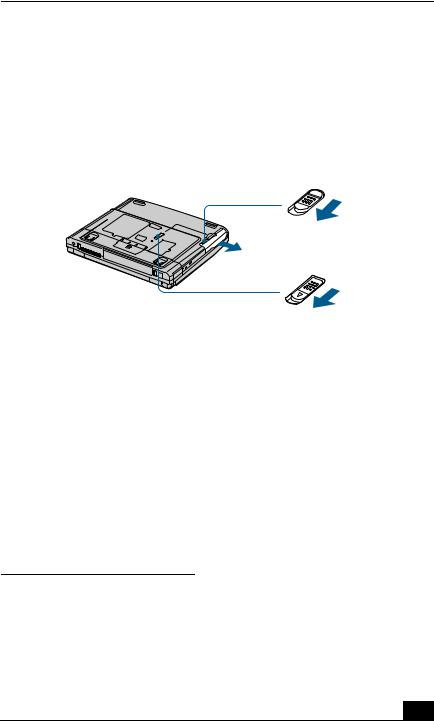
Using Smart Connect
To remove the weight saver
1There is a release lever on the bottom of the weight saver. To remove the weight saver, slide this lever in the direction of arrow 1, then slide the Release lever on the bottom of the notebook in the direction of arrow 2.
Multipurpose bay release levers
Arrow 1: Weight saver Release lever
Arrow 2: RELEASE lever
2After removing the weight saver, pull out the weight saver’s hinged arm and fold it into the weight saver.
Using Smart Connect
Windows Me™
You can connect your VAIO® Notebook to another VAIO computer that has the preinstalled Windows Me operating system or the Sony Smart Connect 3.0 software preinstalled. You may use an optional i.LINK®* cable to connect the two systems and then use one computer to edit, copy, or delete files on the other
*i.LINK is a Sony trademark used only to designate that a product contains an IEEE 1394 connection. The i.LINK connection may vary, depending on the software applications, operating system, and compatible i.LINK devices. All products with an i.LINK connection may not communicate with each other. Refer to the documentation that came with your compatible i.LINK device for information on operating conditions and proper connection. Before connecting compatible i.LINK PC peripherals to your system, such as a CD-RW or hard disk drive, confirm their operating system compatibility and required operating conditions.
27
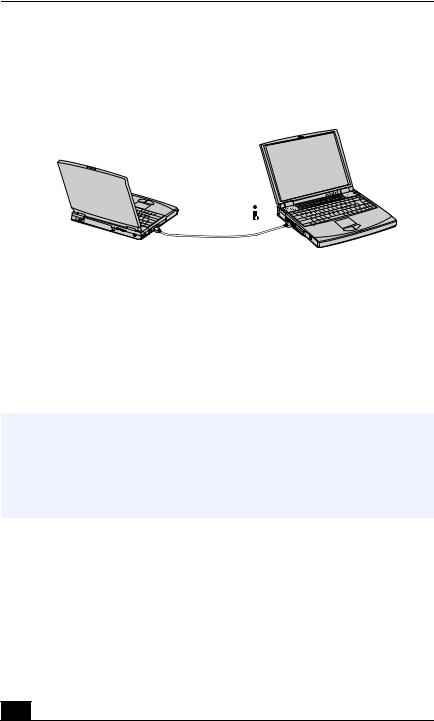
Change text in this variable to document title as each document is created.
computer. You can also print from a printer that is attached to either computer. Select the STD mode in Smart Connect 3.0 software to connect with another computer that has Windows Me preinstalled.
Connecting with an i.LINK cable
i.LINK cable (optional)
Windows 2000
The preinstalled Smart Connect software allows you to use an optional i.LINK® cable to connect your VAIO notebook to another VAIO computer that also has Smart Connect or preinstalled Windows Me. You can then use one computer to edit, copy or delete files on the other computer. You can also print from a printer attached to either computer.
See Smart Connect online help for more information.
When you connect two VAIO computers, you must assign each computer a unique name. The computers can be identified by this unique name when the two computers are networked together.
If you have previously purchased a VAIO computer or notebook that does not have the Windows Me operating system or Smart Connect 3.0 software preinstalled, consult the Sony Web site for support options (http://www.sony.com/pcsupport).
Power Saving Modes
When you use a battery as the source of power for your notebook, you can take advantage of power management settings to conserve battery life. In addition to the normal operating mode, which allows you to turn off specific devices, your notebook has two distinct power saving modes: Standby and Hibernate. When
28

Power Saving Modes
using battery power, be aware that the notebook automatically enters Hibernate mode when the remaining battery charge drops below 5 percent, regardless of the power management setting you select.
If the battery level falls below 10 percent, you should either attach the AC adapter to recharge the battery or shut down your notebook and insert a fully charged battery.
Normal Mode
Normal mode is the normal state of your notebook when it is in use. The power indicator displays green when your notebook is in this mode. To save power, you can turn off a specific device such as the LCD or the hard disk.
Standby Mode
In Standby Mode the notebook saves the current state of the system in RAM and switches off power to the CPU. The amber power indicator flashes in this mode.
To activate Standby mode
To activate Standby mode, press the key combination Fn+Esc, or press the power button and release it immediately. You can also use the PowerPanel utility to enter Standby mode.
To return to normal mode
Press any key to return to normal mode.
Hibernate Mode
In the Hibernate mode, the state of the system is saved on the hard drive and power is turned off. The power indicator is off in this mode.
To activate Hibernate mode
To activate Hibernate mode, press the key combination Fn+F12.
(Windows 2000) The “Save to Disk Manager” screen appears, and then the notebook enters Hibernate mode.
Do not move the notebook until its power indicator turns off.
29

Change text in this variable to document title as each document is created.
To return to normal mode
To return to normal mode, turn on the notebook by pressing the power button. The notebook returns to its previous state.
When returning from Hibernate mode, the system status stored on the hard disk is erased and the notebook starts normally if you press the power button and hold it for more than four seconds.
Time required to return to normal mode
Standby requires less time than Hibernate to return to normal mode.
Power consumption
Standby uses more power than Hibernate.
Connecting a Phone Line
You need to connect a phone cable (supplied with selected models) to take advantage of online services and the Internet.
In order to register your Sony VAIO® Notebook, register your software online, and use Sony Customer Support, you must connect to a phone line.
1 Plug one end of the phone cable into the modem jack on the notebook.
Connecting phone cable
Modem jack
Wall jack
Phone cable (supplied with selected models)
2 Plug the other end into the wall jack.
30
